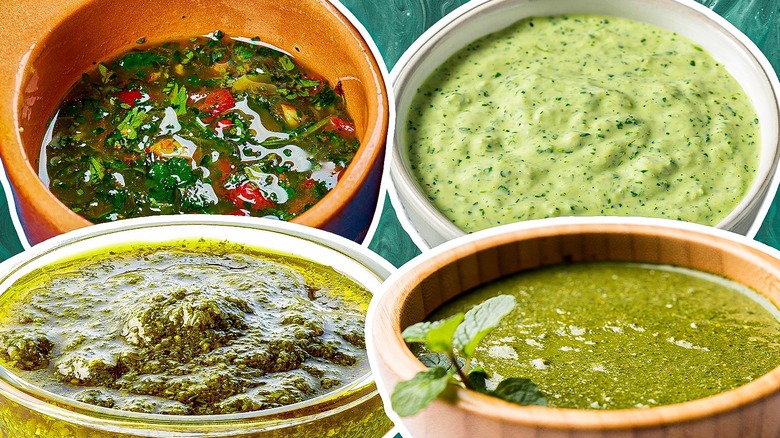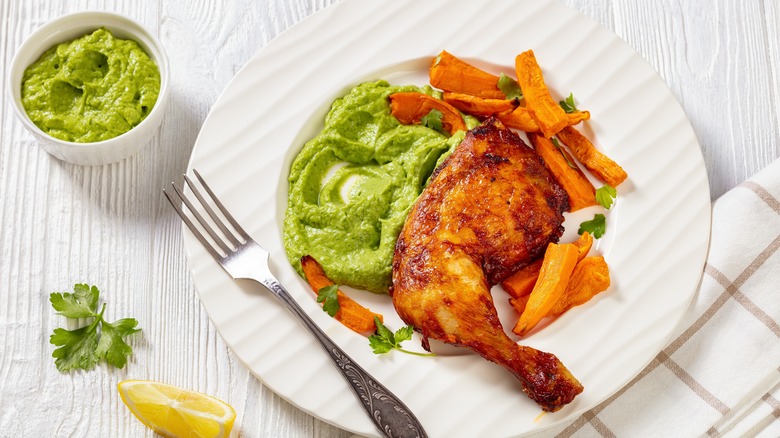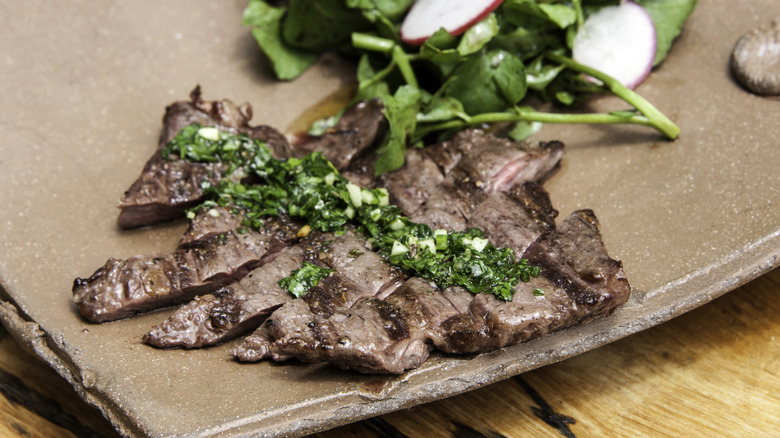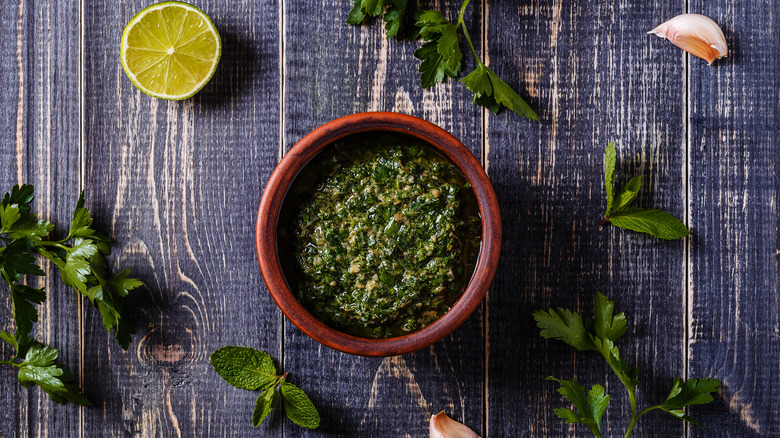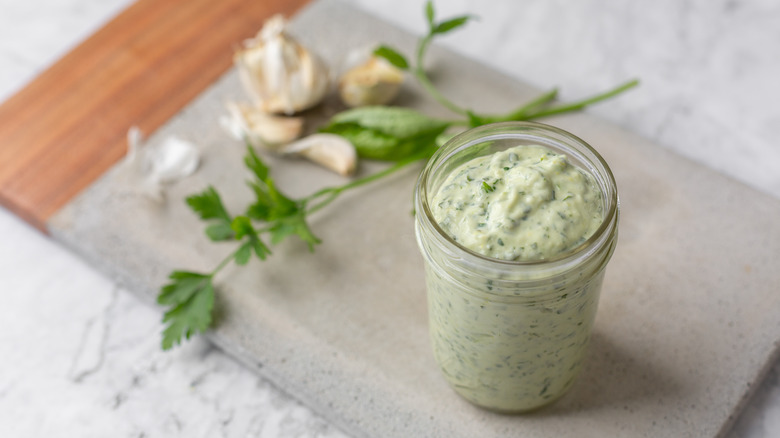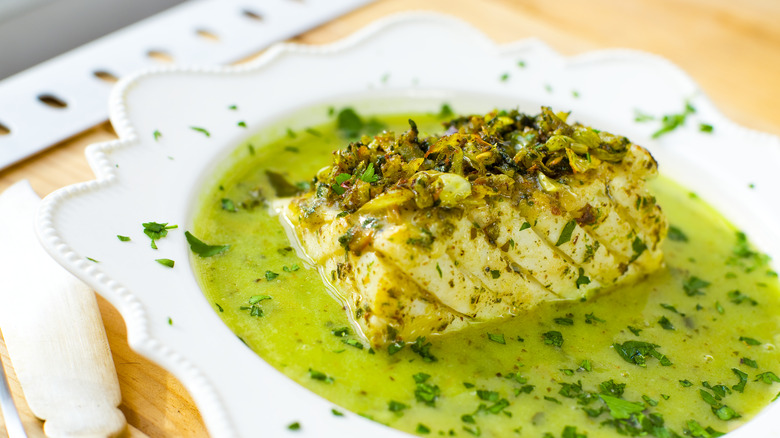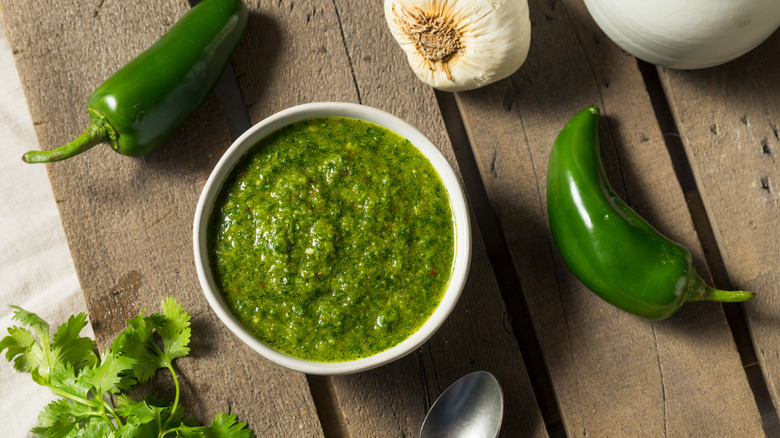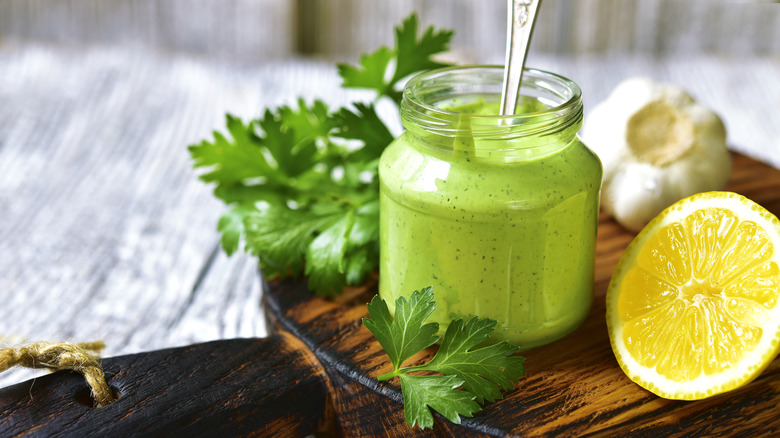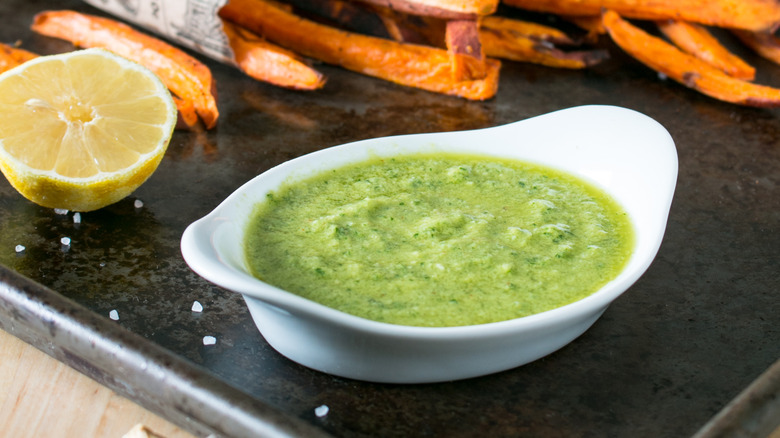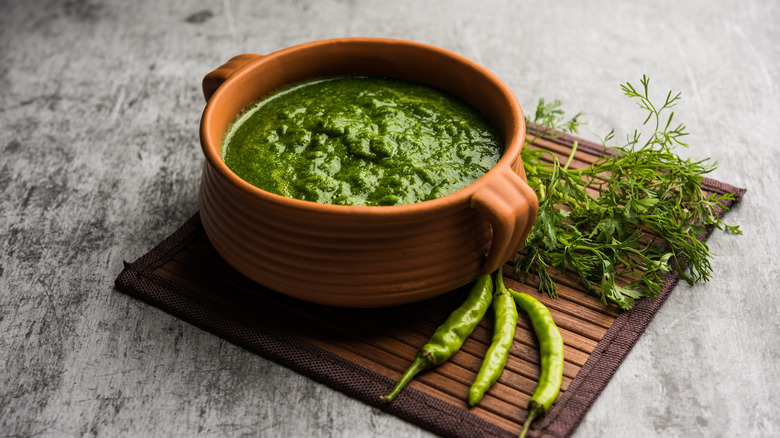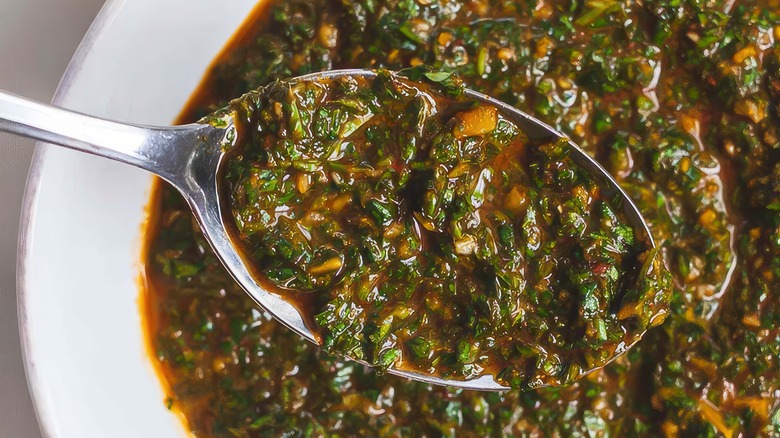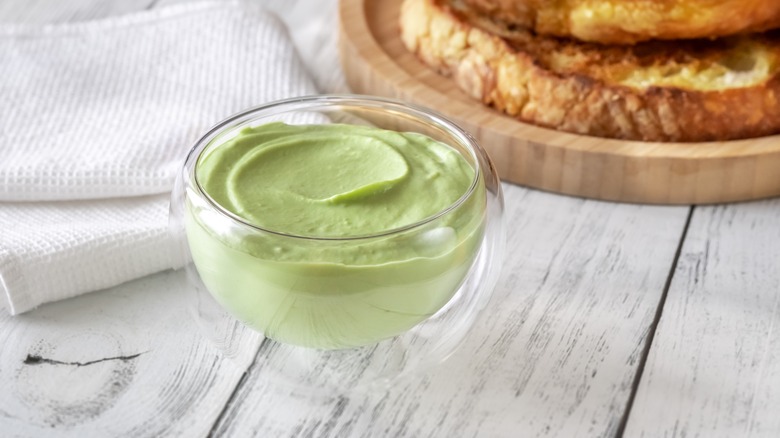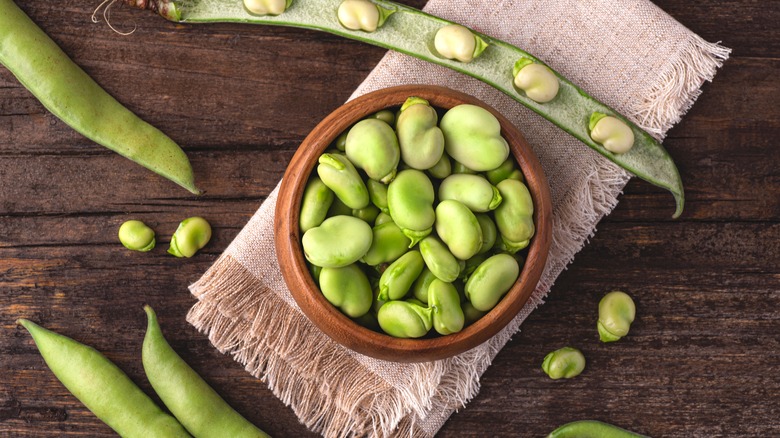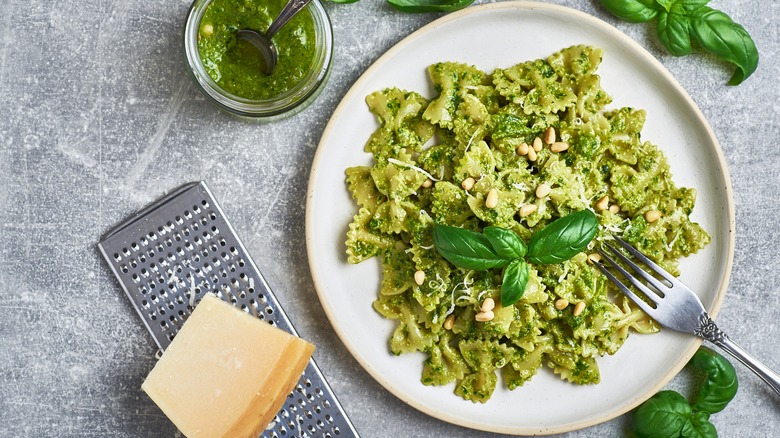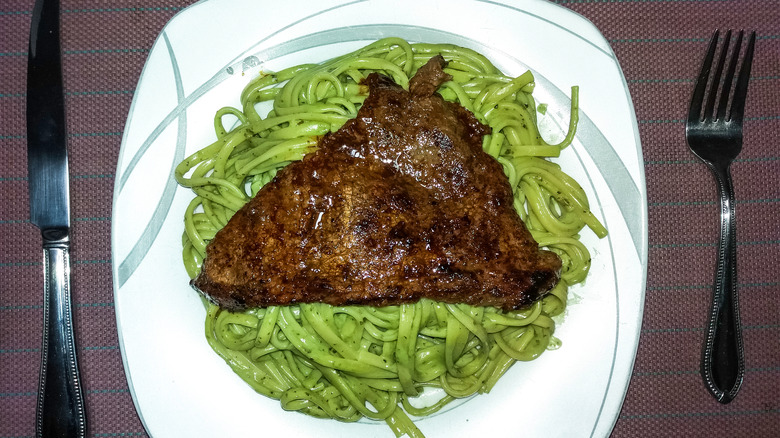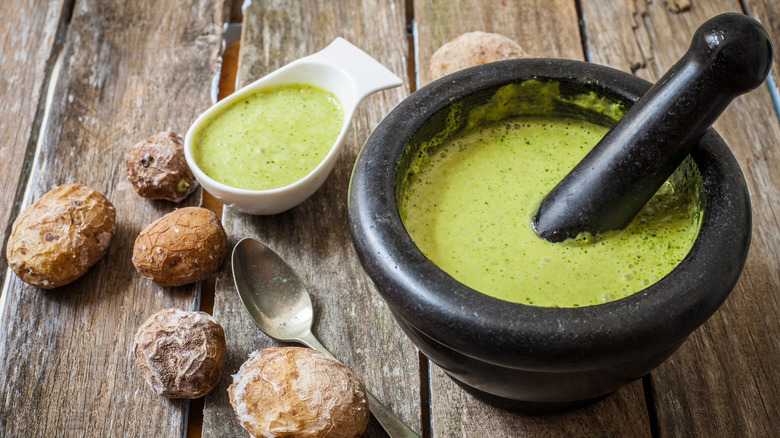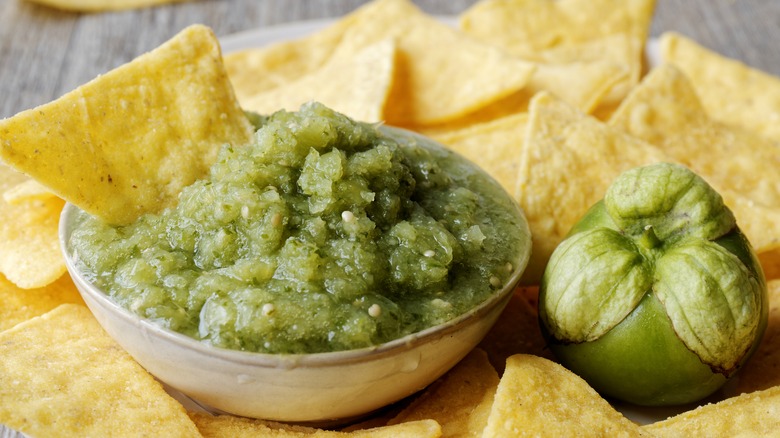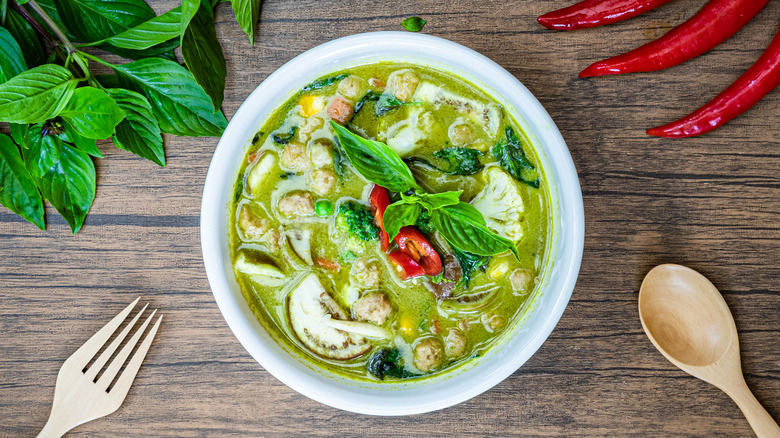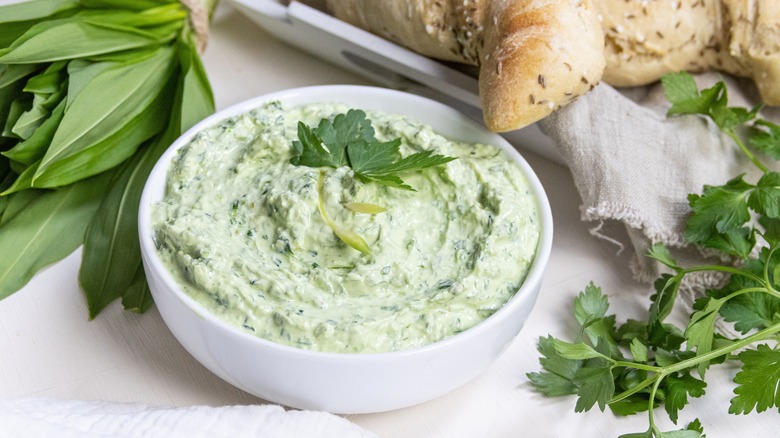19 Types Of Green Sauce You Should Try At Least Once
What do Venezuelan tostones, Afghan bolani, Mexican enchiladas, Spanish cod, Italian pasta, and Thai curries have in common? They are all made or served with a special green sauce from their country. Green sauces are fresh, herby, tangy, and spicy condiments made from fresh herbs, and they exist all over the world as staple parts of many cuisines. Each region has its own traditions, recipes, and variations, but you may be surprised to find many more similarities between the green sauces of the world than differences. Every green sauce featured here contains a generous quantity of fresh herbs, but other kinds of intriguing local ingredients can be responsible for the green color too.
Whether you'd like to add a mild herby freshness or some serious flavor or spice to your meals, green sauces are the answer. Some, but not all, can be found in the supermarket, but the good news is that they are all easy to make at home. Make a traditional recipe or get creative with your own version. The beauty is they go with almost everything. These green sauces are definitely worth trying at least once.
Guasacaca
Many people in the United States are familiar with guacamole, a mashed avocado dish that actually originates from the ancient Aztec Empire. Venezuela has its own version which may be less familiar. Guasacaca, or Venezuelan avocado salsa, is similar to guacamole, but it's more watery and has a smoother texture. This versatile sauce can be used to accompany many kinds of foods. Venezuelans use it to dress cold and grilled meats, yuka, empanadas, cheese tequeños, potatoes, and arepas, as well as using it as a dip for tostones, which are Venezuelan-style fried plantains. This is a simple recipe that can be made in just a few minutes. Just blend or process avocados with chopped scallion, garlic, cilantro, parsley, lime juice, salt, pepper, hot sauce, and a little vinegar. Add a little oil while blending until you reach the desired consistency, which should be quite smooth and creamy.
Chimichurri
Chimichurri is a spicy and aromatic green sauce from Argentina and Uruguay made from parsley, garlic, vinegar, chili peppers, and salt. It's very liquidy and is an excellent way to dress salads or grilled, roasted, and baked meats. It's also used as a marinade for fish and chicken. It's well known around the world and can often be found in supermarkets. Making it at home, however, is pretty straightforward. Finely chopped parsley and a few minced garlic cloves are mixed with ground chili pepper, sweet paprika, oregano, and ground black pepper. Freshly squeezed lemon juice, vinegar, and extra virgin olive oil are then added, and everything is stirred until well mixed. For the best flavor, leave it in the fridge overnight before enjoying it.
Bagnetto verde
Bagnetto verde is a flavor-packed Italian condiment from the Northern Italian region of Piemonte. It's used to dress boiled potatoes and meat, and it's also served on bread with anchovies. For the best results, use the freshest Italian parsley and a very good quality extra virgin olive. It's easy to make but requires a little prep because you will soak the inside white part of crusty bread in red wine vinegar for a few hours ahead of time. Then finely chop a few cups of fresh parsley leaves, finely mince a couple of cloves of garlic and several anchovies, and mash the bread until smooth. Add everything to a bowl and add salt and about a cup of olive oil. Yes, it's supposed to be oily. For best results, refrigerate for up to a day before serving at room temperature.
Green goddess dressing
It wasn't the green color but a play called "The Green Goddess" that was responsible for the name of this dressing. Actor George Arliss was staying in San Francisco's Palace Hotel when starring in the play during its run in the city in the mid-1920s. Hotel chef Philip Roemer invented a creamy dressing made with mayonnaise, fresh herbs, and anchovies and named it after the play. This green goddess dressing recipe uses an aromatic mayonnaise base made from scratch for the freshest flavor. First, fresh parsley, cilantro, and basil are processed with oil to make the base. Before the oil is added to whisked egg yolks to make the mayonnaise, a mixture of shallot, vinegar, garlic, and lemon is added for even more flavor. In the end, mashed avocado provides extra luxuriant creaminess, and fresh tarragon and chervil round out the herby taste.
Salsa verde española
Salsa verde española means "Spanish green sauce," and this version is a traditional dish from Spain and is not related to the well-known Mexican version of the same name made with tomatillos. It's used in Spanish fish and seafood recipes like cod in green sauce, clams in green sauce, and hake meatballs in green sauce. When the fish stock is replaced with vegetable broth, it can be used with vegetarian ingredients like mushrooms and artichokes instead. Unlike many other green sauce versions around the world, this one is cooked, but it only takes a quick ten minutes to prepare. First, chopped onion and garlic are sautéed in olive oil. Flour and white wine are added for thickness and flavor, followed by fish broth, parsley (which turns the sauce green), and salt to taste. It's ready after two or three minutes of cooking over low heat.
Zhug
Zhug, or Schug, is a hot sauce originally from Yemen but is now commonly found in other parts of the Middle East, including Israel. It's very spicy from chilies (this schug recipe contains 20 whole serrano peppers), aromatic from spices like cumin, cardamon, and coriander, and bright from a large amount of fresh cilantro. It's used in the same way as a Latin American salsa verde — made by hand in a mortar and pestle and used to dress a variety of dishes, including traditional dishes such as roast chicken and vegetables, lentils, or raw cucumber and tomato salads. Chef Michael Solomonov uses cardamom and coriander, but he points out that you can play around with other spices like fenugreek as well. He does advise not making the mixture too smooth through overprocessing; some texture is ideal.
Aji verde
Peruvian green sauce is a spicy blend of cilantro, garlic, mayo, lime juice, jalapeño peppers, and other ingredients. Some variations call for cotija cheese or aji amarillo paste, which is available in Mexican markets. Others use basil or honey. Aji verde has a light, fresh, and flavorful taste and is a wonderful condiment for grilled meats. The sauce can also be spooned on top of many other kinds of foods like rice, vegetables, and eggs or used as a dipping sauce. It's simple to make at home, and the spice level can be dialed up or down by using or omitting the hot jalapeño seeds. One version includes romaine lettuce and vinegar. To make it, all you need to do is blend the following ingredients in a blender at once until smooth: romaine lettuce, cilantro for the main flavor, scallions, a jalapeño pepper for the heat, garlic, lime juice for brightness, vinegar for tartness, mayo for the base, cumin, salt, and pepper.
Green aioli
Aioli is a sauce made from emulsified olive oil and garlic that originates from France and other Mediterranean countries. Many versions exist, and some include egg yolks in the emulsion to make a mayonnaise base. To make green herb aioli, just include fresh herbs. First, blend a mixture of herbs (like basil, tarragon, and mint), egg yolks, garlic, lemon juice, and water in a blender. Then slowly add a cup of oil with the blender running until it reaches a thick mayonnaise consistency. Season with salt and pepper to taste. The fun with this sauce is you can create so many variations. If you love the flavor of cilantro, make a version with a generous amount of cilantro instead. Not a fan of mayo? Sub sour cream or Greek yogurt, or just leave the mayo out for a keto version. For a creamy, oil-free, vegan version, replace the egg yolks, mayo, and oil with rich and creamy avocado.
Afghan cilantro chutney
Pickled vegetables and acidic foods are a staple of the cuisine in Afghanistan, and Afghan cilantro chutney, a green sauce with a base of fresh cilantro, is no exception. In fact, this herby, tangy, spicy condiment calls for a whole two cups of vinegar for every four bunches of cilantro. It can be made mild or spicy with the addition of jalapeño pepper or green chili pepper. Garlic, salt, and black pepper round out the flavor. It's quick and easy to make by processing the ingredients in a food processor. Afghan cilantro chutney goes with most Afghan dishes. It's paired with hearty meat dishes or traditional recipes like dumplings or bolani, a stuffed flatbread. If you combine it with yogurt, it turns into a creamier version that's perfect for dipping or dressing salads.
Chermoula
Moroccan cuisine is famous for its use of brightly colored spices with captivating aromas, and chermoula is one of the recipes that combine these spices. This aromatic mixture is a marinade used to prepare fish, poultry, and vegetables; you will get the best results by using fresh garlic and herbs. Besides its use as a marinade, it's used for basting, added to simmering stews, and served as an accompanying sauce to grilled vegetables, fish, or meat. Chermoula can be made in several ways, including a red version featuring paprika or spicy harissa and a yellow one made with turmeric. Green chermoula leaves the red ingredients out. It's made by grinding cilantro, parsley, garlic, salt, cumin, and olive oil in a mortar and pestle.
Maionese verde com alho
This sauce translates to green mayonnaise with garlic and comes from Brazil. It's a delightfully creamy, fresh, tangy cilantro mayo blend with a garlic flavor. You can use it to top burgers, accompany pizza, mix with salad, spread on a sandwich, top toast, serve on the side with grilled meat, or use in any other way you'd like according to your personal taste. It comes together in a few minutes using only a blender. To make it, whole milk, egg, yellow mustard, garlic, cilantro or parsley, salt, and lemon juice are blended. Then, oil is added to the mixture to make the mayonnaise part. With the blender on, vegetable oil is very slowly poured in until the mixture reaches the desired thickness.
Marò di fave
A classic from the region of Liguria in Italy, the name of this sauce means fava bean pesto, and it's a minty, flavorful mixture made from fresh fava beans, also known as broad beans, and mint. This traditional springtime dish is rooted in peasant culture; fava beans and mint were some of the only fresh plants available in early spring in the area, so the people used them to enliven their bread, which had dried out over the winter. This pesto is eaten on bread, served with roast lamb, or used as a pasta sauce. Like regular pesto, it's easy to prepare, and the best results will be achieved using a mortar and pestle (but a food processor can be used if necessary). Fresh, peeled fava beans, mint, garlic, extra virgin olive oil, and salt and pepper make up the basic version. Many recipes call for grated pecorino cheese or nuts like pine nuts or almonds too.
Pesto
Pesto is a popular Italian pasta sauce that's well-known outside of Italy. There are many varieties, but they all are generally made with a base of extra virgin olive oil, garlic, grated cheese (usually pecorino), and salt. Most include a nut like pine nuts, almonds, or walnuts. Two red versions are Calabrian pesto, which includes roasted red pepper and ricotta cheese, and Sicilian pesto, with ricotta cheese and tomato. Green pesto comes from the region of Liguria, and the color comes from the fresh basil leaves that make up the bulk of the sauce. Although basil is traditional, pesto can be made with other green leafy vegetables like rucola as well. Pesto is generally served as a pasta sauce, and it's helpful to know the best pasta to pair with pesto. Shapes with twists and turns are ideal for catching the sauce in their nooks and crannies. Look for fusilli, trofie, casarecce, or gemelli to ensure the most flavorful bite.
Tallarines verdes peruanos
The name of this sauce means Peruvian green noodles, and it's a version of pesto that has become a classic recipe in Peru. In fact, it originated from the pesto brought to the country by Italian immigrants in the 1800s. The Peruvians changed the original recipe to include local ingredients like cheese, milk, and fresh spinach in equal parts to the original basil. The other difference is that the Peruvian version is cooked. This sauce is used to coat spaghetti, and in local style, the final dish often features a steak or other meat like fried chicken or liver. To make it, sautée chopped onion in oil for a couple of minutes along with fresh basil and spinach, and then blend that mixture in a blender with fresh cheese, water, and evaporated milk. More onion is then caramelized and cooked with garlic before the blended mixture, salt, and pepper are added to the pan and mixed well.
Green chutney
Chutney, a flavorful condiment widespread in Indian cuisine, has a green herbal version called dhaniya pudina chutney that is made delightfully flavorful with herbs and spices. There are three ingredients traditionally used to make green chutney: cilantro, green chilies, and mint. In fact, the word dhaniya in the name means "cilantro" in Hindi. Mint is a bit controversial, with some saying you can't leave it out and others believing it has no place in the classic version. Green chutney is quick to prepare. For a basic chutney, all you have to do is blend together cilantro, mint, onion, green chilies, lemon juice, and salt. If it looks too dry, blend in a few tablespoons of water until it looks smooth and creamy. Different variations will call for more ingredients, such as onion, chaat masala powder, curry leaves, ginger, or nuts like almonds or roasted peanuts.
Canarian mojo verde sauce
Most meals served in the Canary Islands include mojo, a word that refers to different local sauces that are garlicky, herby, hot, and spicy. It's used as a flavorful marinade or drizzled on roast potatoes, eggs, and grilled meat, fish, and vegetables. Less traditional but equally delicious, mojo can be enjoyed as a sandwich spread, dip, or salad dressing. Mojo originates from the Canary Islands, and some people may be familiar with other versions of mojo, with colors such as red and orange, brought to countries like Puerto Rico, Cuba, and Caribbean countries by Canarian immigrants. Mojo verde, the green version, is easy to prepare and comes together in about ten minutes using a mortar and pestle or a food processor. Mix together cilantro, garlic, olive oil, cumin, lime juice, and white wine vinegar. It also calls for Canarian hot green peppers, but if you can't get those, sub jalapeños instead.
Salsa verde
Salsa verde is a spicy Mexican green sauce traditionally made with tomatillos, cilantro leaves, and serrano chilies. It's a staple used to make enchiladas, top tacos, serve with nachos, dress eggs, and more. There are many ways to make it. The tomatillos can be raw or roasted, you can mix and match the herbs, and you can dial the spice up or down. The best part is you can quickly make delicious salsa verde at home using a blender. For raw salsa, blend together tomatillos, cilantro, serrano chilies, onion, and salt. You can add water for a thinner version if you like. To make the cooked version, cook the same ingredients in a small amount of water for fifteen minutes before blending. You can even add avocado to your salsa verde for a creamy version.
Green curry paste
Curry paste is the basis for Thai curries, delicious dishes loaded with spice and flavor. It's easily found in supermarkets, but nothing beats the flavor of the homemade version, not to mention the aromas that will fill your kitchen. And if you make it ahead, you can store the extra in the freezer for up to a year, making it much easier to whip up delicious curries when you want them. The recipe for green and red curry paste is actually the same because the color comes from the kind of peppers used. Dried red chilies are used for the red version, and fresh green chilies are used to make green curry paste. The recipe includes ingredients like Kaffir lime, cilantro, Thai chili peppers, galangal, lemongrass, ginger, garlic, and coriander. For a quicker version, blend everything in a food processor. For a more traditional route, first, toast the spices in a pan and grind everything by hand in a mortar and pestle.
Agliata verde
Garlic lovers rejoice: there is an Italian condiment similar to pesto but with much more of this strong and fragrant ingredient. Agliata verde is a historical precursor to pesto, said to originate in the Middle Ages. It's a garlic sauce made creamy from soft local toma cheese and green from fresh herbs, and it takes its name from the Italian word for garlic (aglio) and the word for green (verde). The traditional version from the region of Piemonte calls for several cloves of garlic, toma cheese, fresh parsley, sage, basil, mint, and celery leaves, extra virgin olive oil, salt, and lemon juice, which are ground together in a mortar and pestle. Ricotta cheese can be used if toma is not available, and you can also play around with which herbs you include. Some versions call for only parsley. Try it spread on toasted slices of crusty Italian bread.
